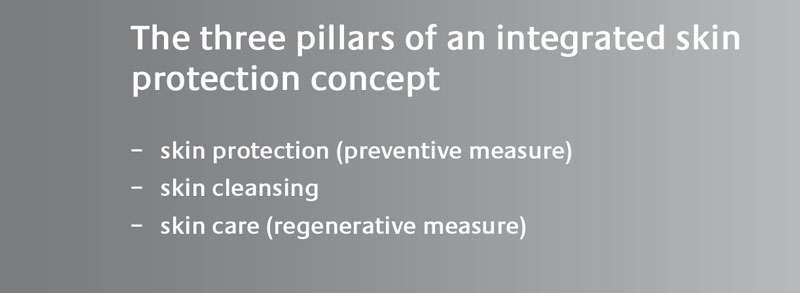
Effective Prevention due to Skin Care
Prevention is the best medicine – a principle that also holds true for occupational skin diseases. Consequently applied skin care is the best solution to maintain the health of strongly stressed skin. In order to be effective, the protective measures have to be taken right from the beginning of the occupational skin exposure. If skin diseases already occurred, it may already be too late to avert a case of dermatitis.
An efficient occupational skin care concept includes preliminary measures applied before work as well as the most gentle cleansing possible and an effective care after performing the stressing activities. In this regard, all measures have to be adapted to each other as well as to the health hazards of the respective work performed.
Skin Protection
Most of the strains the skin is exposed to during work result from direct contact with potentially hazardous substances. Skin protection products prevent these specific substances from entering the skin. The protective lotions, creams and gels are applied before work and operate together with the natural horny layer of the epidermis in order to establish an effective barrier against hazardous substances. Essential for an efficient protection is the exact knowledge of the substances the skin is exposed to during work. Usually, there is no universally applicable and effective skin protection agent. Therefore, the applied products have to be chosen in exact accordance with the hazardous substances constituting a skin danger at the respective workplace.
Skin Cleansing
The choice of the right skin cleansing agent is of great importance. Skin, which is already occupationally stressed, must not be strained by the cleansing agent additionally. However, at the same time, dirt – and hence, hazardous substances – have to be completely removed. As a rule of thumb: the higher the cleansing effect of a product, the higher the possible skin strain. For this reason, an unnecessarily strong skin cleanser should never be used. In terms of product selection, the kind of dirt has to be considered in order to ensure an optimum effect in combination with maximum skin protection. In some companies, it might be reasonable to provide several skin cleansing agents which are graded according to efficiency and which can be applied as required. Thus, an unnecessarily strong product will not be used.
Preparation and Implementation of an Integrated Skin Care Concept
1. Definition of work and work area
- Which activity does the employee perform exactly?
2. Identification and evaluation of potential skin hazards
- Is there a hazard due to direct or indirect skin contact? (TRGS 401*)
- Are there mechanical, biological or physical hazards?
3. Identification and realisation of protective measures
- Substitution of hazardous substances, if possible
- Technical protective measures (e.g. closed system)
- Organisational protective measures (e.g. clean and tidy workplaces)
- Personal protective measures (Personal Protective Equipment)
- Regular occupational health checks, if applicable
- Comprehensive instruction of employees
- Clear marking of workplaces and dispensers with the help of pictograms
4. Documentation
- Documentation of risk assessment in writing
- Preparation of operating instructions, group data sheets, etc.
- Preparation of hand protection and skin protection instructions
5. Supervision of efficiency
- Regular examination of realised protective measures
- Regular examination whether the employees comply with the protective measures
* The Technical Rule for Hazardous Substances TRGS 401 “Risks resulting from skin contact – identification, assessment, measures” specifies the requirements and assertions of the Ordinance on Hazardous Substances concerning skin-stressing activities more precisely.
Skin Care
As the third pillar of an integrated skin protection concept, skin care products ensure, with their regenerative features, that the barrier function of the stressed epidermis is sustained in the long term. Skin care creams are applied to the previously cleaned skin after work; they bind water within the skin and contain fat and oil, which smooth the horny layer. As a result, skin care products compensate for the loss of moisture from stress, water, detergents or fatdissolving substances.

